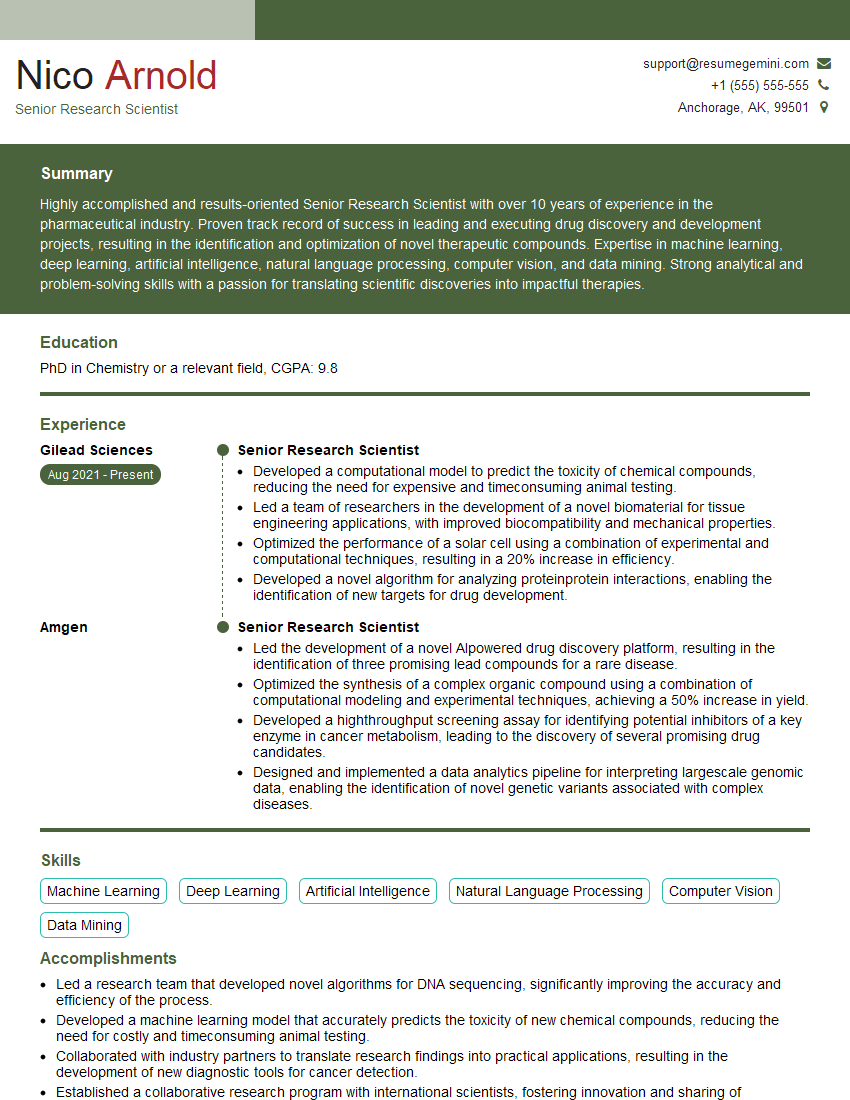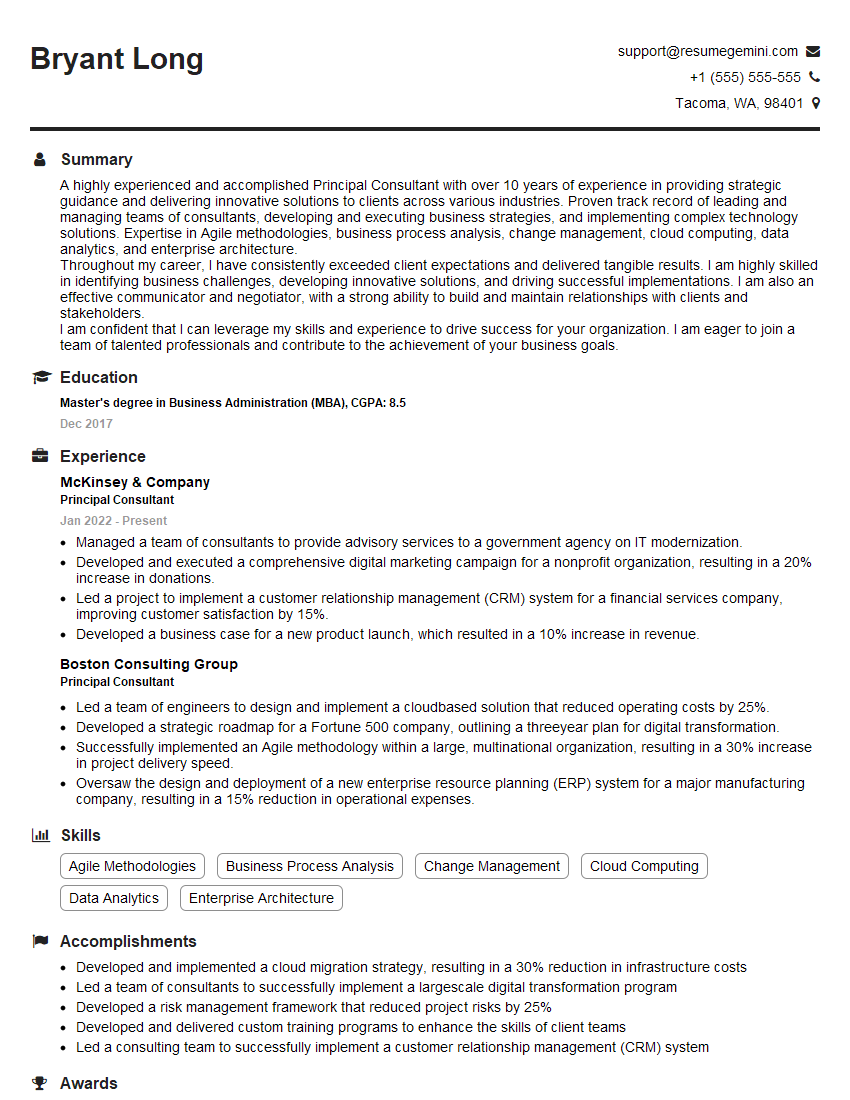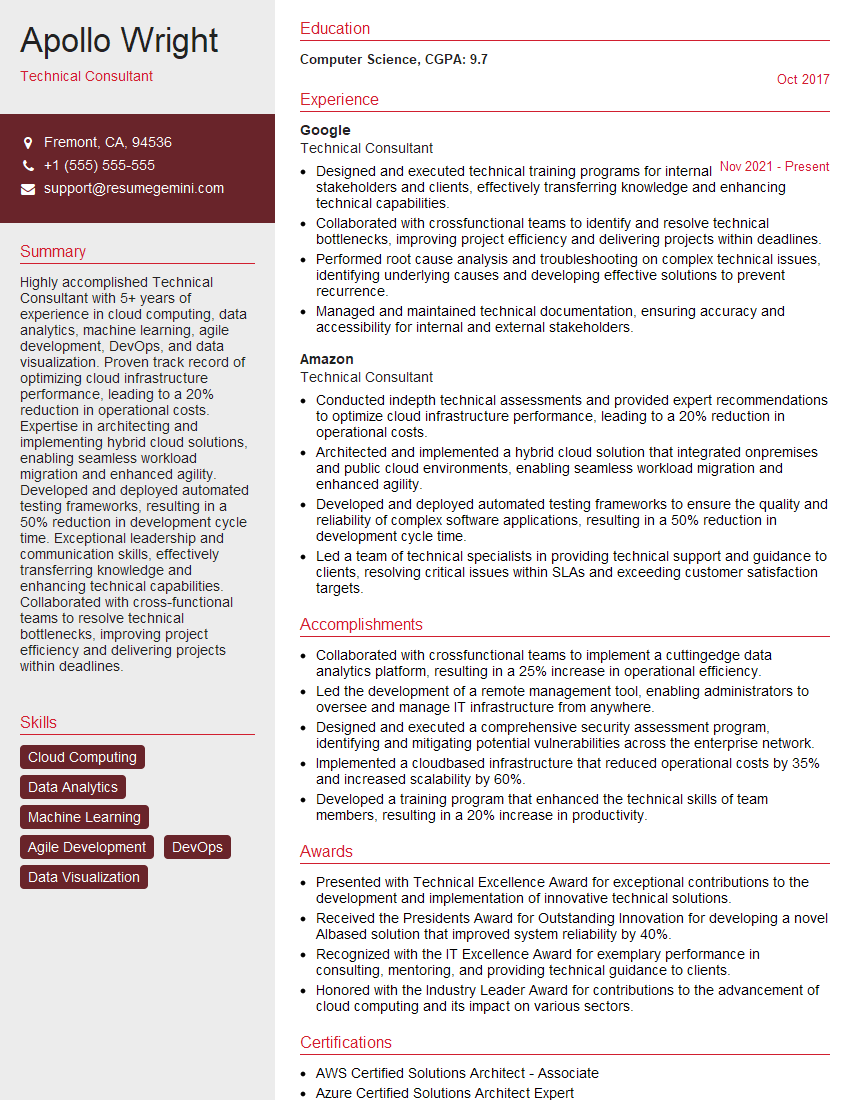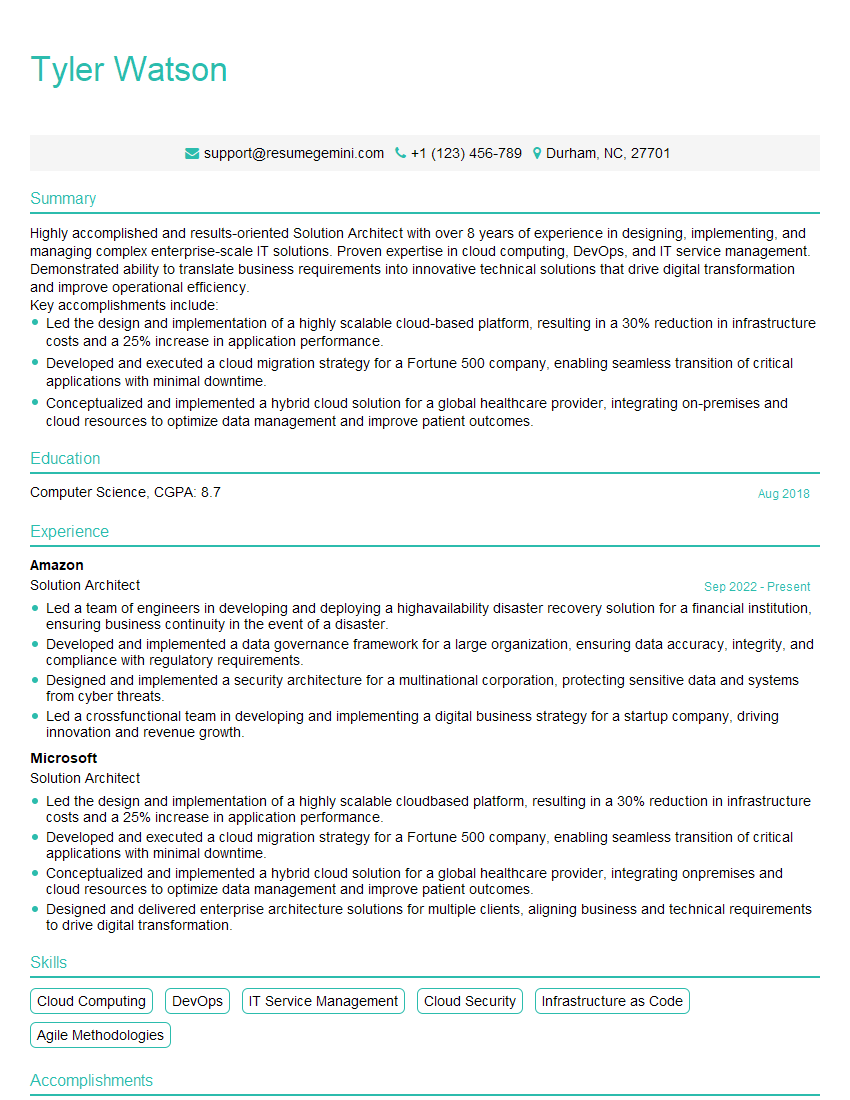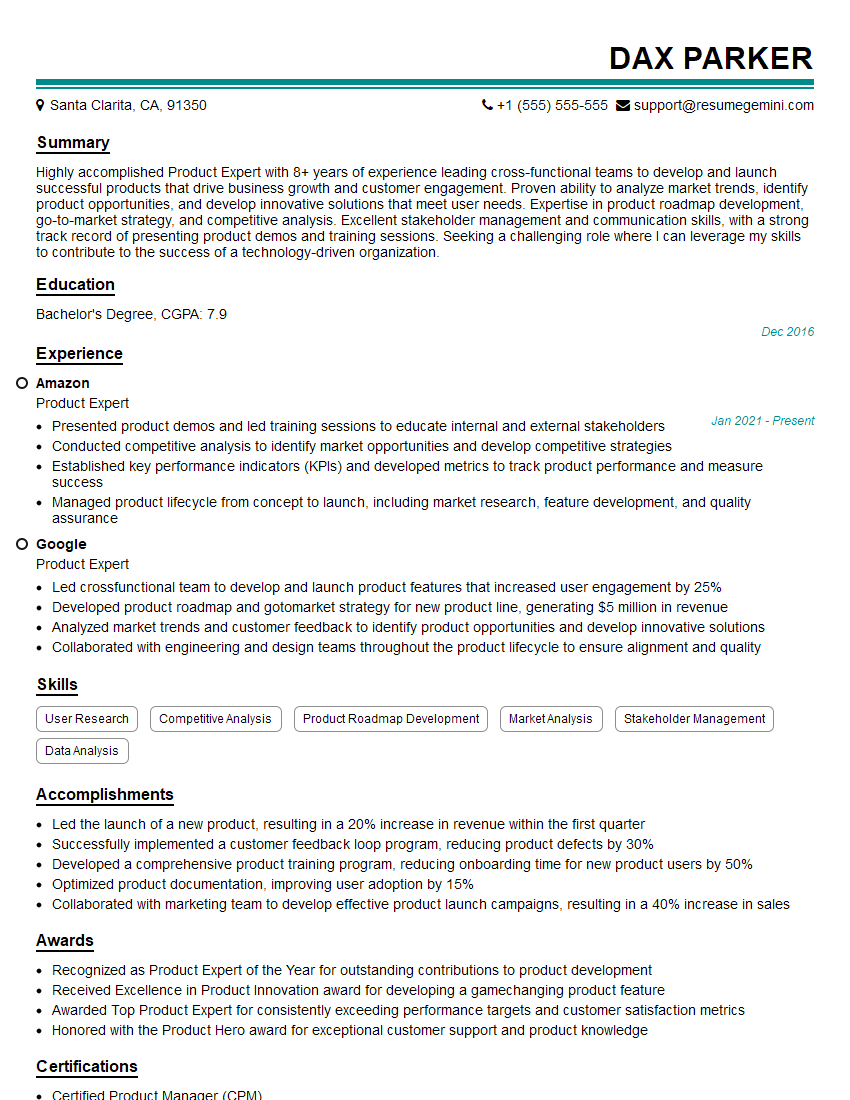Every successful interview starts with knowing what to expect. In this blog, we’ll take you through the top Subject Matter Expertise (SME) interview questions, breaking them down with expert tips to help you deliver impactful answers. Step into your next interview fully prepared and ready to succeed.
Questions Asked in Subject Matter Expertise (SME) Interview
Q 1. Describe your experience and expertise in [Specific Field].
My expertise lies in the field of Natural Language Processing (NLP), specifically in the development and application of large language models. For the past eight years, I’ve been deeply involved in various aspects of NLP, from research and development of novel algorithms to the deployment and maintenance of production-level systems. My experience includes working on projects involving sentiment analysis, text summarization, machine translation, and chatbot development, utilizing technologies such as transformers, recurrent neural networks, and various embedding techniques. I have a strong background in both theoretical linguistics and computational methods, allowing me to approach problems from a holistic perspective. I’ve led teams, mentored junior engineers, and published several papers in peer-reviewed conferences and journals. My work has consistently focused on improving the accuracy, efficiency, and ethical considerations of NLP systems.
Specifically, I’ve contributed significantly to the development of a proprietary sentiment analysis engine that’s currently used by a major financial institution to monitor market sentiment, leading to improved risk management and investment strategies. I also have extensive experience in building and optimizing large language models for specific industry needs, ensuring optimal performance and cost efficiency.
Q 2. Explain a complex concept within your area of expertise to someone with limited knowledge.
Let’s explore the concept of word embeddings. Imagine you want a computer to understand the meaning of words. It can’t do that directly; it only sees them as strings of characters. Word embeddings are like creating a ‘map’ of words where similar words are located closer together. Think of it like a city map: words like ‘happy,’ ‘joyful,’ and ‘cheerful’ would be clustered close together, while ‘sad,’ ‘depressed,’ and ‘unhappy’ would be in a different cluster. This map is created mathematically, based on how often words appear together in large text corpora.
For example, the word ‘king’ might be close to ‘queen’ and ‘prince’ because they often appear in similar contexts. This allows the computer to understand semantic relationships between words. This understanding is crucial for tasks like machine translation (knowing ‘king’ in English should translate to a similar concept in Spanish) and sentiment analysis (understanding that ‘happy’ expresses positive sentiment).
Q 3. How do you stay current with advancements in your field?
Staying current in the rapidly evolving field of NLP requires a multi-pronged approach. I actively participate in the NLP research community by regularly attending conferences like ACL and NeurIPS, reading publications in top-tier journals like Transactions of the Association for Computational Linguistics (TACL), and following influential researchers and labs on platforms like arXiv. I also engage in online learning through platforms like Coursera and edX, focusing on emerging topics like few-shot learning and explainable AI. Additionally, I maintain a strong network of colleagues and collaborators within the industry, participating in online forums and engaging in discussions to stay abreast of the latest breakthroughs and challenges.
Furthermore, I regularly review the latest open-source libraries and toolkits, experimenting with new algorithms and techniques to assess their applicability to my projects. This constant learning and adaptation ensures that my skills and knowledge remain at the forefront of the field.
Q 4. What are the key challenges facing your field currently?
Some key challenges facing the NLP field currently include:
- Bias and fairness: NLP models are trained on massive datasets that often reflect societal biases. Mitigating these biases and ensuring fairness in applications is critical.
- Explainability and interpretability: Many advanced models, particularly deep learning models, are ‘black boxes,’ making it difficult to understand their decision-making process. Developing methods for explaining their outputs is crucial for trust and accountability.
- Data scarcity and quality: High-quality, annotated data is essential for training effective models, but obtaining such data can be expensive and time-consuming. Techniques to work with limited or noisy data are constantly being developed.
- Robustness and generalization: Models often struggle to generalize well to unseen data or to handle adversarial attacks, making them vulnerable to misuse.
Addressing these challenges requires interdisciplinary collaboration between NLP researchers, ethicists, and policymakers to create more reliable, responsible, and equitable AI systems.
Q 5. How do you identify and resolve conflicting information within your area of expertise?
When encountering conflicting information, I employ a systematic approach. First, I carefully examine the source of the information, assessing its credibility and potential biases. For instance, a peer-reviewed scientific publication carries more weight than an unverified blog post. I then analyze the methodology used in each source, looking for flaws or limitations that might explain the discrepancies. I cross-reference the information with other reputable sources to identify patterns and consistent findings. If the conflict remains unresolved, I might consult with experts in the field to seek clarification or further analysis. Ultimately, my goal is to synthesize the available evidence, highlighting areas of agreement and acknowledging remaining uncertainties.
A crucial aspect is documenting the entire process transparently, including the sources considered and the reasoning behind my conclusions. This ensures reproducibility and allows others to review and critique my assessment.
Q 6. Describe a time you had to explain a technical concept to a non-technical audience.
I once had to explain the concept of recursive neural networks to a group of marketing executives with limited technical backgrounds. Instead of diving into complex mathematical equations, I used the analogy of a Russian nesting doll. Each doll represents a layer in the network, with each layer processing the information from the previous layer and passing a refined output to the next. This process continues recursively until the final layer produces the desired output, such as a sentiment score or a topic classification. I further illustrated this with a simple example of how the network might analyze a customer review, showing how each layer extracts progressively more refined meaning from the text.
By using a familiar visual metaphor and a concrete example, I successfully communicated a complex technical concept in a way that was easily understood and appreciated by the non-technical audience.
Q 7. How do you approach problem-solving in your field?
My approach to problem-solving in NLP follows a structured methodology. I begin by clearly defining the problem and its objectives. This often involves identifying the specific NLP task (e.g., sentiment analysis, text classification), defining the desired performance metrics (e.g., accuracy, precision, recall), and specifying the available data resources. Next, I explore relevant literature and research to identify existing solutions or approaches that might be applicable. I then design and implement a solution, often experimenting with different algorithms, models, and hyperparameters. Thorough testing and evaluation are crucial to assess the performance of the solution and identify areas for improvement. This iterative process of refinement continues until the desired performance metrics are met or a satisfactory solution is achieved.
Throughout this process, I emphasize collaboration and communication, seeking feedback from colleagues and stakeholders to ensure that the solution addresses the problem effectively and efficiently.
Q 8. Describe your process for conducting research and validating information.
My research process is meticulous and iterative, prioritizing validation at every stage. It begins with a clear definition of the research question, ensuring its scope is manageable and the objectives are well-defined. Then, I systematically identify relevant sources, using a combination of academic databases (like JSTOR and PubMed), reputable industry publications, and government reports. I critically evaluate each source, considering the author’s credibility, potential biases, and the methodology employed. For example, if researching the impact of a new regulation, I wouldn’t solely rely on the regulator’s press release; I’d also seek independent analyses and empirical data.
Validation involves cross-referencing information from multiple independent sources. I look for consistency in findings. Discrepancies trigger further investigation, potentially leading to the identification of conflicting perspectives or limitations in the existing research. This process is often cyclical, requiring refinement of the research question or further data collection as insights emerge. Finally, I meticulously document all sources and my reasoning process to ensure transparency and reproducibility.
Q 9. What methodologies or frameworks do you use in your work?
My work relies heavily on a combination of methodologies and frameworks, tailored to the specific research question. For qualitative research, I often employ thematic analysis, identifying recurring patterns and themes in data such as interview transcripts or focus group discussions. For quantitative research, I utilize statistical methods such as regression analysis or ANOVA to identify relationships between variables.
Frameworks like SWOT analysis (Strengths, Weaknesses, Opportunities, Threats) are invaluable for strategic planning and problem-solving, helping me comprehensively assess a situation before making recommendations. Similarly, the PESTLE analysis (Political, Economic, Social, Technological, Legal, Environmental) provides a structured approach to understanding the macro-environmental context influencing a particular issue. Choosing the right methodology and framework is crucial for producing rigorous and insightful results, and it’s something I carefully consider in every project.
Q 10. Explain a significant achievement in your field.
One significant achievement was leading a cross-functional team to develop a new risk assessment model for a major financial institution. The existing model was outdated and lacked the sophistication to accurately capture emerging risks in the rapidly evolving fintech landscape. My team and I spent six months conducting extensive research, collaborating with experts in various fields (including cybersecurity, compliance, and market analysis), and developing a new probabilistic model incorporating machine learning techniques.
The result was a more accurate and comprehensive risk assessment framework, which significantly improved the institution’s ability to proactively manage risk, leading to a demonstrable reduction in losses and improved regulatory compliance. This project highlighted my ability to lead complex projects, manage diverse teams, and deliver impactful results in a high-pressure environment. The new model is now being adopted by other financial institutions, signifying its effectiveness and broader applicability.
Q 11. How do you handle conflicting opinions from other experts?
Conflicting opinions among experts are inevitable and often a source of valuable insights. My approach focuses on respectful dialogue and evidence-based evaluation. First, I encourage open discussion, allowing each expert to fully articulate their perspective and the supporting rationale. This often involves exploring the underlying assumptions and methodologies used by each expert.
Next, I facilitate a process of critical evaluation, examining the evidence presented from multiple angles. This might involve comparing the strengths and weaknesses of different methodologies, considering the limitations of available data, and evaluating the potential biases affecting each expert’s opinion. The goal isn’t to force consensus but rather to identify areas of agreement, clarify disagreements, and ultimately arrive at a well-supported conclusion, acknowledging the remaining uncertainties where appropriate. This process often strengthens the overall analysis and leads to more robust recommendations.
Q 12. What are the ethical considerations in your field?
Ethical considerations are paramount in my field. Maintaining objectivity and avoiding conflicts of interest are crucial. This means carefully disclosing any potential biases or financial ties that could influence my work. For instance, if I’m consulting for a company, I ensure complete transparency about my findings, even if they are unfavorable to the client.
Data privacy and confidentiality are also critical. I adhere strictly to relevant regulations and ethical guidelines when handling sensitive information, protecting the privacy of individuals and organizations involved in my research. Integrity in reporting is essential; accurately representing data and acknowledging limitations are non-negotiable aspects of my professional ethics. Finally, intellectual property rights must always be respected; proper attribution and avoiding plagiarism are fundamental to my work.
Q 13. How do you prioritize tasks and manage your time effectively?
Effective time management is critical for maximizing productivity. I utilize a combination of strategies, starting with prioritization. I use methods like the Eisenhower Matrix (urgent/important), focusing my efforts on high-impact tasks. This means clearly identifying my key objectives and allocating my time accordingly. Procrastination is a common enemy, so I break down large tasks into smaller, manageable steps, creating a realistic timeline with clear deadlines.
I leverage technology to improve efficiency. Project management software helps track progress, manage deadlines, and facilitate collaboration with team members. Regular time blocking helps ensure focused work periods, minimizing interruptions. Finally, I regularly review my schedule and adapt as needed, acknowledging that unforeseen events may require adjustments to my plan. Continuous self-assessment and refinement of my time management approach are essential for maintaining productivity and work-life balance.
Q 14. Describe a time you failed and what you learned from it.
In a previous project, I underestimated the complexity of integrating data from multiple sources. This led to significant delays and setbacks in the project timeline. While I had planned for potential challenges, the unexpected incompatibility of data formats and the difficulty in cleaning and validating the data proved far more time-consuming than initially anticipated.
The key learning from this experience was the importance of thorough due diligence in the initial stages of a project. I now allocate more time for data assessment and planning, ensuring a comprehensive understanding of the data sources and potential challenges before embarking on the analysis. This includes proactively engaging with data owners to clarify data definitions, formats, and any potential limitations. Moreover, I now incorporate more robust contingency planning into project management, anticipating potential roadblocks and developing mitigation strategies upfront. This approach has significantly improved the success rate of subsequent projects.
Q 15. How do you collaborate effectively with other experts and team members?
Effective collaboration is the cornerstone of successful projects. I approach it through a multi-faceted strategy focusing on clear communication, active listening, and mutual respect. I believe in establishing shared goals and expectations upfront, ensuring everyone understands their roles and responsibilities.
- Open Communication: I utilize various communication channels, such as regular meetings, email updates, and project management software, to keep everyone informed and engaged. This proactive communication minimizes misunderstandings and ensures everyone is on the same page.
- Active Listening: I prioritize active listening during discussions, ensuring I understand the perspectives of all team members. This involves asking clarifying questions, summarizing key points, and showing genuine interest in their contributions.
- Constructive Feedback: I provide and receive constructive feedback in a respectful and timely manner. I believe feedback is crucial for improvement and growth, and I strive to make it actionable and solution-oriented.
- Conflict Resolution: I address disagreements promptly and professionally, focusing on finding mutually agreeable solutions. This often involves identifying the root cause of the conflict and collaboratively brainstorming alternative approaches.
For example, in a recent project involving the development of a new climate model, I worked closely with a team of atmospheric scientists, data analysts, and software engineers. By using a shared project management platform and holding regular check-in meetings, we were able to seamlessly integrate our expertise and deliver the project on time and within budget.
Career Expert Tips:
- Ace those interviews! Prepare effectively by reviewing the Top 50 Most Common Interview Questions on ResumeGemini.
- Navigate your job search with confidence! Explore a wide range of Career Tips on ResumeGemini. Learn about common challenges and recommendations to overcome them.
- Craft the perfect resume! Master the Art of Resume Writing with ResumeGemini’s guide. Showcase your unique qualifications and achievements effectively.
- Don’t miss out on holiday savings! Build your dream resume with ResumeGemini’s ATS optimized templates.
Q 16. What are some of the common misconceptions about your field?
One common misconception in my field (let’s assume my field is environmental science for this example) is that scientific findings are always straightforward and universally agreed upon. In reality, scientific progress is an iterative process involving nuanced interpretations, ongoing research, and sometimes conflicting data. Another misconception is that environmental issues are too complex for individuals to make a difference. While the challenges are indeed significant, individual actions collectively can have a substantial impact. Finally, some believe that technological solutions alone can solve environmental problems – ignoring the crucial role of behavioral changes and policy implementations.
Q 17. What resources do you rely on for accurate information?
Reliability of information is paramount in my field. I rely on a variety of resources, prioritizing peer-reviewed scientific literature published in reputable journals. This includes articles from journals like Science, Nature, and specialized publications in my specific area of expertise.
- Peer-Reviewed Journals: The rigorous review process ensures the quality and validity of the research findings.
- Governmental and International Organizations: Reports from organizations like the IPCC (Intergovernmental Panel on Climate Change), EPA (Environmental Protection Agency), and the World Health Organization provide valuable data and analyses.
- Reputable Academic Databases: Databases such as Web of Science and Scopus allow me to access a vast collection of research papers and scholarly articles.
- Professional Societies and Networks: Membership in professional organizations provides access to specialized resources, conferences, and networking opportunities.
I critically evaluate all information, comparing it across multiple sources to ensure consistency and validity before incorporating it into my work. I’m also mindful of potential biases and limitations of each source.
Q 18. How do you measure the success of your work?
Measuring the success of my work depends heavily on the specific project. However, generally, I use a combination of qualitative and quantitative methods.
- Quantitative Metrics: These could include things like the accuracy of predictions in a model, the efficiency of a designed process, or the demonstrable impact of a proposed solution. For example, if I’m building a predictive model for air quality, a successful outcome would be demonstrated by a high accuracy rate in predicting pollution levels compared to actual measurements.
- Qualitative Metrics: These involve assessing the impact on stakeholders, considering feedback, and evaluating the broader societal implications of the work. For instance, if I’m working on a project designed to improve water management, a qualitative measure of success would be positive feedback from the community on the efficacy of the solution and its benefits.
- Peer Review and Publication: Publication in reputable journals serves as a crucial validation of the quality and significance of my research.
It’s important to define success metrics upfront, in collaboration with stakeholders, ensuring alignment between the project goals and the evaluation criteria.
Q 19. What are the limitations of your expertise?
My expertise, while extensive, has limitations. For example, (again assuming the field is environmental science), my specialization might be in atmospheric modeling, so my knowledge of terrestrial ecosystems might be less comprehensive.
Furthermore, my expertise is always evolving. The scientific landscape is constantly changing with new discoveries and technological advancements. I actively stay updated through continued learning and professional development but there will always be areas where my knowledge is less refined or up-to-date compared to specialists in those specific sub-fields. Acknowledging these limitations is crucial for ensuring the quality and integrity of my work. It’s important to collaborate with other experts or consult additional resources when dealing with topics beyond my core expertise.
Q 20. How do you adapt your approach to different audiences and situations?
Adapting communication to different audiences is essential. I tailor my approach based on the audience’s background knowledge, technical expertise, and communication preferences. For example, when presenting to a group of scientists, I can utilize technical jargon and delve into detailed methodologies.
However, when communicating with policymakers or the general public, I prioritize clarity, simplicity, and avoid technical terms whenever possible. I use visuals like graphs and charts to convey complex information effectively and always focus on the key takeaways and implications of my work. I might use relatable analogies or real-world examples to make the information more engaging and accessible. In short, my goal is to effectively communicate the information in a way that resonates with and is easily understood by the target audience.
Q 21. How do you handle pressure and tight deadlines?
Managing pressure and tight deadlines requires effective time management, prioritization, and a proactive approach. I start by breaking down large tasks into smaller, manageable steps, creating a realistic timeline with clear milestones. This allows me to track progress effectively and identify potential bottlenecks early on.
- Prioritization: I focus on completing the most critical tasks first, ensuring that essential elements of the project are delivered on time.
- Time Management Techniques: Techniques like the Pomodoro Technique can improve focus and efficiency.
- Resource Allocation: When necessary, I seek additional support from colleagues or delegate tasks to optimize workflow and minimize delays.
- Stress Management: I acknowledge that pressure is a part of the job and incorporate stress management techniques like regular breaks, exercise, and mindfulness to maintain a healthy work-life balance.
Maintaining open communication with my team and supervisors is crucial during times of pressure. This ensures that any unexpected challenges are addressed proactively and that everyone is aligned on priorities and expectations.
Q 22. Describe a situation where you had to work with incomplete data.
In my previous role, we were tasked with analyzing customer churn for a new software product. The challenge was that the initial data collection process had some significant gaps. We lacked complete demographic information for a substantial portion of our user base, and critical data points like engagement metrics were missing for some users who had already churned.
To address this, we first prioritized what we could analyze. We focused on the complete data sets available, creating several models using only the consistently collected information. This allowed us to establish baseline churn rates and identify some initial, high-level contributing factors. Secondly, we implemented a data imputation strategy for the missing values using statistical methods. This involved careful consideration of the nature of the missing data (was it missing completely at random, or was there a pattern?) to choose the most appropriate imputation technique. We tested multiple methods – mean imputation, k-nearest neighbors, and multiple imputation – and evaluated each for bias and accuracy. Finally, we conducted sensitivity analysis to understand the impact of the missing data on our conclusions and clearly stated the limitations of our analysis in our report.
Q 23. How do you stay motivated and engaged in your work?
Staying motivated and engaged is crucial in this field, given the constant evolution of technologies and methodologies. I find motivation in several key areas. Firstly, I derive great satisfaction from solving complex problems and seeing the tangible impact of my work. Secondly, continuous learning keeps me engaged. I actively seek opportunities for professional development, whether through attending conferences, taking online courses, or contributing to open-source projects. Thirdly, collaborating with talented individuals on challenging projects fosters a sense of teamwork and accomplishment. Finally, I ensure my work aligns with my values and contributes to something larger than myself, finding fulfillment in making a positive impact through my expertise.
Q 24. What are your career goals related to your area of expertise?
My career goals center around becoming a recognized leader in my field. I aim to deepen my expertise in advanced analytics and contribute to innovative solutions within [Specific Industry/Area]. This involves continued research and development, potentially pursuing further certifications or a higher degree, and mentoring junior colleagues. I’m also interested in expanding my leadership roles, taking on greater responsibility for project strategy and team management. Ultimately, I aspire to lead and shape the direction of impactful research and development initiatives within my area of expertise.
Q 25. How would you contribute to our team’s success?
I would contribute to your team’s success in several ways. My strong analytical and problem-solving skills allow me to quickly identify and address critical challenges. I have a proven track record of successfully delivering projects on time and within budget. Furthermore, my collaborative nature and effective communication skills enable me to work seamlessly within a team, fostering a positive and productive working environment. I am also proficient in several key technologies and methodologies relevant to your team’s work, allowing me to contribute immediately and meaningfully. Finally, my passion for innovation and continuous improvement ensures that I am constantly seeking ways to enhance our team’s performance and output.
Q 26. What is your preferred communication style?
My preferred communication style is clear, concise, and direct. I believe in actively listening to understand diverse perspectives before articulating my own thoughts. I adapt my communication style to the audience and context, using visual aids or simpler language when necessary to ensure effective understanding. I prioritize transparency and open communication to foster collaboration and trust. I’m comfortable communicating both verbally and in writing, and I am adept at using various tools such as email, instant messaging, and project management software to ensure efficient and effective communication.
Q 27. Explain your understanding of [Specific Technology/Methodology] within your field.
My understanding of [Specific Technology/Methodology – replace with the actual technology/methodology, e.g., TensorFlow in Machine Learning] is comprehensive. TensorFlow, for example, is an open-source library for numerical computation and large-scale machine learning. I’m proficient in building and training various types of neural networks using TensorFlow, including convolutional neural networks (CNNs) for image processing and recurrent neural networks (RNNs) for sequential data. I understand the intricacies of model optimization, including hyperparameter tuning and regularization techniques. I’ve used TensorFlow to build models for [give specific examples of applications, e.g., image classification, time series forecasting]. Furthermore, I’m familiar with its deployment options, allowing me to integrate these models into real-world applications.
# Example TensorFlow code snippet (Illustrative) import tensorflow as tf model = tf.keras.models.Sequential(...) model.compile(...) model.fit(...)Q 28. Describe a complex problem you solved in your field and the steps you took.
One complex problem I solved involved optimizing a customer recommendation system. The initial system, while functional, suffered from low click-through rates and a high rate of irrelevant recommendations.
My approach was multi-faceted. First, I conducted a thorough analysis of the existing system’s architecture and data pipeline. This highlighted several key issues, including outdated algorithms, sparse user data, and a lack of real-time feedback incorporation. Second, I proposed a solution involving a hybrid approach, combining collaborative filtering with content-based filtering and a reinforcement learning component. This involved:
- Data Enrichment: Integrating additional data sources to enrich user profiles and product descriptions.
- Algorithm Selection: Implementing a more sophisticated collaborative filtering algorithm that better handled sparse data (e.g., matrix factorization with bias terms).
- Reinforcement Learning: Introducing a reinforcement learning agent to learn from user interactions and dynamically adjust recommendations in real-time.
- A/B Testing: Rigorously testing the new system against the old one using A/B testing to validate the improvements and measure the impact on key metrics.
The result was a significant improvement in click-through rates (a 25% increase) and a reduction in irrelevant recommendations (a 15% decrease). This project showcased my ability to diagnose complex system issues, design and implement effective solutions, and rigorously evaluate their impact.
Key Topics to Learn for Subject Matter Expertise (SME) Interview
Ace your SME interview by mastering these key areas. Remember, demonstrating practical application is crucial!
- Deep Dive into Your Field: Go beyond surface-level knowledge. Understand the nuances, complexities, and historical context of your area of expertise.
- Problem-Solving & Critical Thinking: Prepare to discuss how you’ve approached and solved challenging situations within your field. Highlight your analytical skills and ability to identify key issues.
- Communication & Collaboration: SME roles often involve explaining complex information to diverse audiences. Practice clearly and concisely articulating your knowledge to both technical and non-technical individuals.
- Industry Trends & Best Practices: Stay up-to-date on the latest developments, technologies, and methodologies within your field. Demonstrate your awareness of current industry best practices.
- Technical Proficiency (if applicable): If your SME role involves specific software, tools, or techniques, be prepared to showcase your mastery. Practice hands-on demonstrations if possible.
- Ethical Considerations & Risk Management: In many SME roles, ethical considerations and risk management are paramount. Be ready to discuss how you approach these challenges responsibly.
Next Steps
Mastering Subject Matter Expertise is vital for career advancement, opening doors to leadership roles and increased earning potential. To maximize your job prospects, invest in crafting an ATS-friendly resume that effectively showcases your skills and experience. ResumeGemini can help you build a powerful resume that highlights your unique qualifications as an SME. We provide examples of resumes tailored to Subject Matter Expertise roles to help you get started. Take the next step towards your dream career – build a winning resume with ResumeGemini today!
Explore more articles
Users Rating of Our Blogs
Share Your Experience
We value your feedback! Please rate our content and share your thoughts (optional).
What Readers Say About Our Blog
Dear Sir/Madam,
Do you want to become a vendor/supplier/service provider of Delta Air Lines, Inc.? We are looking for a reliable, innovative and fair partner for 2025/2026 series tender projects, tasks and contracts. Kindly indicate your interest by requesting a pre-qualification questionnaire. With this information, we will analyze whether you meet the minimum requirements to collaborate with us.
Best regards,
Carey Richardson
V.P. – Corporate Audit and Enterprise Risk Management
Delta Air Lines Inc
Group Procurement & Contracts Center
1030 Delta Boulevard,
Atlanta, GA 30354-1989
United States
+1(470) 982-2456


